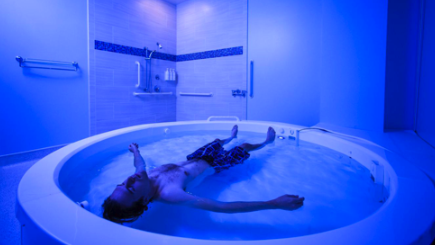
So What The Hell Is Float Therapy?
Earlier this year Mindbody revealed its 2020 Wellness Index, a research study based in Australia ranking the nation’s fitness, health, and beauty behaviours.
In an ever-changing world, it’s sometimes hard to keep up with the latest and greatest wellness trends. While four or five years ago everyone was talking about Cryotherapy (turns out it’s not a room you cry in, as I assumed), in 2020 you may hear things like “float therapy” or “float rooms” thrown around more often.
Why is this? As it turns out, for young Australians “experiential wellness” is on the rise. In our increasingly busy and hectic lifestyles we’re trialling more and more fitness and wellness activities to calm ourselves down, with float spas leading the charge alongside things like meditation studios and nap bars.
If you’re anything like me, the thought of float therapy sounds absolutely terrifying. Are you trapped in a small floatation device? Are you meant to wear clothes? What if I somehow, accidentally, got locked in?! Would my family and friends even know I was missing?
We decided it was time to find out what it was all about.
We talked to James Hogg from Saltuary about Float Therapy and the benefits surrounding it.
What is float therapy and what are the benefits of it?
“Float therapy involves lying down in what’s essentially a big bath, filled with hundreds of kilos of salt (usually Epsom salt) in body temperature water, which allows you to float,” James told us.
“It’s very relaxing! It takes a huge load off the body, as the water (filled with salt) completely supports you (gravity-free), allowing every muscle and aspect of your being to switch off and relax. It’s said that 1 hour in a float room is akin to 4 hours of sleep on your body due to the deep relaxation it brings. It can be a helpful treatment for people suffering from things like depression and anxiety-related disorders too as it helps the body to relax so deeply.
“We like to say that it’s like a bridge between your conscious and subconscious mind, allowing you to access parts of your brain & self that you struggle to connect with in your ‘normal’ day to day waking life. Sportspeople also use it for recovery post events, as the magnesium-rich water helps to balance out the lactic acid, and feeds the muscles a replenishing dose of magnesium.”
What should people know before undertaking float therapy?
“It’s generally better not to have a huge meal beforehand or be so hydrated that you will need to run to the toilet (as this is hard in the middle of a float!),” James said.
“Different places have different types of floats too, like ours for example, are ‘rooms’, so they’re really big and spacious (especially helpful for anyone who suffers with claustrophobia!).”
How much on average does it cost?
“Saltuary offers an intro session for $55, and an intro pack of 3 for $160. We also offer multi-packs and memberships for people who are keen to float regularly, which makes it very cost-effective.”
Would doing float therapy heighten anxiety or claustrophobia if people suffered from these issues?
“It’s generally beneficial for most anxiety sufferers, and although claustrophobia can be a concern for some, using a big ‘room’ can help to alleviate that (you can even stand up in ours!). There are also options to leave the lights on in the float room (ceiling and floor lights) whilst you get accustomed to it.”
And there seems to be some confusion online: do you wear bathers/swimmers or nothing at all?
“This is a question we get a lot, and the answer is, it doesn’t really matter! Of course all of the marketing materials you see are of people wearing bathing suits, but when you are in there by yourself, feel free to do whatever feels most comfortable for you – even if that’s your birthday suit!”
Why do you think float therapy has been identified as a key wellness trend for Australia in 2020?
“There are quite a few factors involved, including a rise in more high profile people using floating as part of their wellness plan as it offers so many benefits,” James told us. He also said a number of elite sporting clubs/organisation are using floating for both recovery and positive psychology (visualisation).
“It’s a deeply restorative, powerful treatment, which also natural. It can be used from a very physical level for sore muscles, through to people seeking deeper spiritual insights and breakthroughs,” James said.
TBH, he had us at the whole “one hour = four hours of sleep” thing. Sign me tf up!

